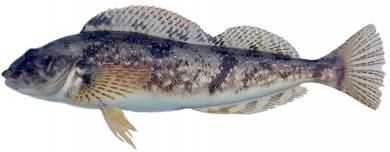Whitespotted Greenling

Species Details
Hexagrammos Stelleri
Hexagrammidae
Scorpaeniformes
Inshore, Rocky Shores
1 - 4 lbs.
8" - 19"
Whitespotted Greenling (Hexagrammos stelleri) Description
The whitespotted greenling is dark golden-brown on top with shades of green towards its underside and light spots and dark patches across its body. It may have a reddish hue and several dark markings as well. It’s similar to its cousins the kelp greenling and rock greenling.
It has 22-25 dorsal spines, 19-24 dorsal rays, and 23-25 anal soft rays that have dark lines or markings. Its tail has a yellow hue and is slightly forked. The whitespotted greenling has five lateral lines, but the first and fourth are shorter in length. It has a barbel or cirrus above its eyes.
Diet & Size
The whitespotted greenling primarily feeds on worms, crustaceans, and small fishes. It’s a small fish with a typical size of 8-15 inches in length. They may grow up to 19 inches long and weigh 3.53lbs.
Interesting facts about the Whitespotted Greenling
- The male whitespotted greenling will guard the eggs during the winter.
- The male’s fins will temporarily get darker in the winter.
- The eggs are a bright turquoise or mauve color.
- Males are more brightly-colored than females
- Greenlings are known to be more of scavengers than predators
How to Catch a Whitespotted Greenling
The whitespotted greenling spawns in October and November, which is the best time to catch the adults. Spring is also a recommended season to fish for them. Recommended hot spots are when the tide is coming in and one should situate themselves around structures where the current is disrupted such as rocky shores, piers, breakwaters, seawalls, and kelp forests.
A light or medium spinning tackle with a braided line or abrasion resistant fusion line should be used, especially for those doing high-speed vertical jigging. Using a special flatfish rig will help, but anglers can also rig one of their own by attaching three snoods or gangions at the end of the main leader. A 10lb-test with a monofilament line would work well. If rigging your own, you need to make sure the snoods are equidistant from each other, and that they won’t tangle up.
Since whitespotted greenlings have compact mouths and nip at the line timidly, size 2-4 hooks are necessary. A sinker can also be used, such as round sinkers or slinks to weigh it down.
When choosing bait, sand shrimp is the best choice for the whitespotted greenling, as this is a favorite for anglers when fishing sea trout, sand perch, and smallmouth bass. Natural baits are more attractive to this fish, but other baits to try would be mussels, clams, leeches, eels, or worms. If using a flatfish rig or a modified one with snoods, trying different kinds of bait to see which one the whitespotted greenling takes is an advantage.
For those that want to try a different method, using a telescoping fiberglass rod is a popular strategy for fishing in rocky waters. These kinds of rods give an edge when hooking species such as the whitespotted greenling in areas that are difficult with a traditional rod. A 30-40 pound test monofilament line with a size 4 long shank hook and a splitshot sinker about 12-15 inches above the bait holder should be effective.
Some recommended spots around British Columbia would be Bryden Bay, French Creek, and Horseshoe Bay. In Washington State, U.S.A., the reef waters near the KVI Tower dive site in Vashon Island, and Three Tree Point near Puget Sound are known areas to explore.
Habitat & Distribution
The whitespotted greenling is a demersal marine fish that is usually found inshore near rocks, pilings, piers, eelgrass beds, and kelp forests. There have been reports that it can be found in shallow, sandy shores as well. It can be found in the intertidal zone up to 574 feet but has been known to dwell between up to 985-1500 feet.
This game fish is found in the North Pacific waters from the Oregon Coast and Washington State in the United States, all the way to the Sea of Japan and Peter the Great Gulf in Russia. There have been reports of the whitespotted greenling in Cape Lisburne in the Chukchi Sea and Unimak Island off the coast of Alaska. They are also common in the kelp forests of British Columbia during summer and are known to frequent eelgrass beds.







